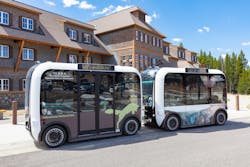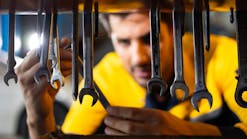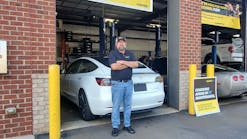Beep, an autonomous shuttle program based out of Florida, operates an autonomous shuttle at Yellowstone National Park.
With companies like Cruise and Waymo deploying in autonomous vehicles in California, Beep is looking to set itself apart from the crowd and offer a unique perspective on the ways in which autonomous vehicles can shape our world view.
The National Parks Service describes the effort as a pilot project of sorts to determine how feasible short-length shuttle services can be in other parks.
The system is up and running now, but ADAPT reached out back when the vehicle autonomy company announced a move to Yellowstone. Beep CEO, Joe Moye, talked about the program and its historic location in an interview that offered insight into the new grounds that vehicle technology is reaching.
Q: Why did Beep choose to partner with the National Parks Service?
A: Beep sees tremendous value in working alongside NPS and Yellowstone National Park to test out these technologies as they look to improve the visitor experience at the park.
Q: What is the vehicle design of the AVs that will be operating in Yellowstone?
A: Beep proposed three AV platforms to NPS during the proposal. They all seat eight to 10 passengers. The designs are very accommodating with a modern look and a full step-in cabin with a low profile designed for a comfortable and friendly rider experience. We will be selecting the final brand of autonomous shuttle before the end of the year in concert with NPS based on the ultimate route selected for the service.
The vehicle is fully driverless following a fixed route at a controlled speed. Each shuttle will be supported and monitored by an onboard specialist and our Beep Global Command Center to ensure the safe operation of the vehicle.
Q: How does Beep hope to improve viewer experience with the use of AVs in National Parks?
A: The two electric autonomous shuttles Beep will deploy in the Village Canyon area of Yellowstone National Park have large glass windows and an open design enabling passengers to experience and see the outdoors while riding in the vehicle.
The attendant onboard will also serve as both an ambassador to autonomous technology and to the park by providing information to riders about key destinations along the route.
Q: How is the path decided?
A: Multiple paths are under consideration with the Yellowstone team and we are supporting this planning effort. Ultimately, the objective is to conduct this test in an area which will provide expanded mobility to a good sample of visitors and campers connecting various lodges, camping areas and other services in Canyon Village.
The shuttle stops and frequency will also be evaluated with the Beep and Yellowstone team to provide a level of service that best accommodates visitors’ needs.
Q: How does Beep ensure the vehicle will not damage the landscape it occupies?
A: Our vehicles operate on a fixed route engineered by our team and do not deviate from the predetermined path. The vehicles are equipped with a series of sensors (camera, radar and LiDAR) to provide a 360-degree view of the environment around the vehicle.
This allows it to detect cyclists, pedestrians, wildlife, other vehicles or anything that may be in the vehicle’s path or alongside the vehicle.
Q: What's in the future for Beep?
A: We are also operating and currently planning two Florida Department of Transportation funded projects utilizing autonomous shuttles to work in concert with their existing transit network and services.
Beep sees value in testing these autonomous vehicle platforms in various use cases and environments, including Yellowstone National Park. It is our hope and goal to have the opportunity to engage other projects at Yellowstone and other parks upon the successful testing of this service. We have many ongoing projects in private and public communities but this will be our first with the National Park Service.





